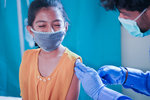



The What, How, and Why of the Fall Vaccines – Influenza, COVID-19 and RSV.
The Centers for Disease Control (CDC) recommends an annual influenza vaccine for everyone over 6 months of age. Why get a Flu vaccine? (cdc.gov)
Influenza infection can make you feel miserable for days or weeks with fever, sore throat, runny nose, cough, muscle aches, headaches, and fatigue. Children can experience vomiting and diarrhea. It can cause sinus and ear infections and flare-up asthma. Worse complications include severe pneumonia, myocarditis, encephalitis, myositis (serious inflammation of the heart, brain, and muscles), sepsis, and death. The elderly, those with heart or lung disease, young children, and pregnant women are at higher risk of complications. It’s not ‘just a cold.’
Flu vaccines are made from inactivated whole viruses grown on eggs through a time-consuming process.
Viruses mutate to evade humans’ immune systems so they can survive by infecting us. They are tricky critters. Mutations are referred to as variants or strains.
Virologists and epidemiologists figure out the most likely influenza strains for next season. Vaccine manufacturers use those strains to make next year’s shots.
Vaccine effectiveness varies yearly depending on the virus types and the vaccine match. If the scientists get it wrong, more people get sick despite vaccination. Predicting viral mutation is tricky.
When the match is good, the vaccines reduce the severity of illness even if you get infected. We know this by measuring doctors’ visits during the flu season. Flu vaccines reduce hospitalizations, ICU admissions, and death.
This year’s vaccine will be trivalent, meaning it will include three virus strains: influenza A virus, H1N1 and H3N2, and influenza B virus Victoria.
It is because of virus mutations and the short duration of influenza vaccine immunity that we need vaccines annually to be protected.
Your physician or pharmacist can advise you about which vaccine to get. Some are for kids, others for adults. Three more potent flu vaccines are designed for people> over 65, intended to trigger stronger immunity for those at the highest risk.
For the 2024-5 season, two COVID vaccines have been approved by the Food and Drug Administration (FDA) and one has an EUA (Emergency Use Authorization).
Like influenza vaccines, COVID-19 vaccines need to be changed yearly to maintain our immunity and keep up with the constantly changing variants. Sars-Cov2 viruses that cause COVID-19, are tricky, perhaps trickier than influenza viruses because they change so fast. It is the spike protein, which our immune recognizes to fight the infection, that keeps changing.
Novavax vaccine has EUA authorization. It is the first adjuvanted subunit vaccine against COVID-19. Subunit vaccines contain a part, or subunit, of the targeted virus. This one contains the spike protein of the JN.1 variant of the Omicron strain, which is the predominant strain circulating now. The adjuvant is a substance added to boost the recipient’s immune response. Subunit technology has been used longer and takes longer to manufacture than the other COVID-19 vaccines.
Pfizer and Moderna each have FDA-approved mRNA vaccines.
mRNA vaccines contain a copy of the virus messenger RNA that acts as a director for the recipients’ cells to produce the protein that it ‘encodes’ (in the case of COVID-19 vaccines, the spike protein of the virus type circulating).
The Pfizer and Moderna vaccines code for the spike protein of the KP.2 strain, one of the five variants descended from the JN.1 Omicron strain.
These vaccine types are much quicker to manufacture than either whole virus or subunit vaccines. mRNA technology is the miraculous breakthrough that emerged during the COVID-19 pandemic when the speed of vaccine production was vital.
Is there a difference between these three vaccines’ effectiveness?
Unlikely. There are no clinical studies of the 2024-5 COVID-19 formulations because we cannot study the future. The FDA authorized them based on the effectiveness and safety of the previous year’s vaccines, the manufacturing processes of which remains unchanged. Last year’s mRNA vaccines were 36-58% effective against getting ill and/or hospitalized.
CDC recommends that all persons >6 months old be immunized, with children aged six months to 11 years eligible for the Moderna and Pfizer vaccines only. A two-month wait from the last COVID-19 vaccine is required.
All three can cause brief and mild adverse effects that include soreness at the injection site, headache, muscle aches, fatigue, and vomiting. Serious side effects such as heart inflammation are rare and are highest in adolescents and young adult males.
This vaccine is specifically indicated for adults over the age of 75 and those aged 60-75 with an increased risk of severe lung illness caused by RSV.
There are three FDA-approved RSV vaccines. Moderna’s is an mRNA vaccine. GSK and Pfizer vaccines are RSV F protein antigen subunit vaccines. All are ~75% effective in protecting against RSV hospitalization. For now, only a single dose is recommended, and it is good for two years. Stay tuned for more on RSV vaccines.
I suggest ‘eligible’ recipients discuss the pros and cons of the RSV vaccine with their doctor, healthcare provider, and/or pharmacist.
All three viruses cause epidemics in the late fall and winter when we are inside and in closer contact with others. The vaccines take two weeks to activate your immune system and be effective. Vaccine immunity begins to wane in six months. Timing matters.
Getting vaccinated in September through late October is ideal. If you need to wait, by all means, get them in November or even December when they still have time to work. COVID-19 is thriving in our midst already.
YES. COVID vaccine can be co-administered (i.e. given at the same time as) with other vaccines including influenza and RSV. Since all three can cause soreness at the injection site, consider using opposite arms. Discuss this with the professional administering the vaccines.
Since these vaccines can cause side effects that include ‘feeling ill’ for a day or two (because your immune system is activated), consider getting the vaccines when your next day is clear of important commitments.
An ounce of prevention is worth a pound of cure…happy and healthy autumn!
Debra L. Glasser, M.D., is a retired internal medicine physician in Olympia. Got a question for her? Write drdebra@theJOLTnews.com
1 comment on this item Please log in to comment by clicking here
Brookewickham
Thanks Debra for another very helpful and easy to understand health article!
3 days ago Report this